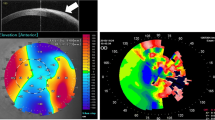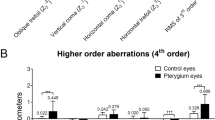Abstract
Purpose
To study the Scheimpflug’s imaging and corneal biomechanics in primary pterygium.
Methods
A prospective observational study of 55 patients with unilateral primary nasal pterygium was done. The normal fellow eyes of patients with pterygium were taken as controls. Clinical parameters noted included visual acuity, values of corneal curvature by doing Scheimpflug imaging, wavefront aberrations in terms of higher and lower-order aberrations and corneal hysteresis (CH) as well as corneal resistance factor (CRF) values by using ocular response analyzer.
Results
Of the total 55 patients, mean age was 43.0 + 11.4 years (range: 20–72 years). Mean LogMar uncorrected visual acuity in pterygium eyes and control eyes was 0.21 + 0.20 and 0.12 + 0.15, respectively (p = 0.016). On Scheimpflug imaging the mean anterior corneal curvature values (Ka1/Ka2 D) were 41.09 + 3.38/44.33 + 2.29 in pterygium eyes, 43.13 + 1.79/43.98 + 2.17 in control eyes (p < 0.0005) and mean posterior corneal curvature (Kp1/Kp2 D) values were 6.14 + 0.39/6.53 + 0.43 in pterygium eyes and 6.13 + 0.28/6.46 + 0.47 in control eyes (p > 0.05). Analysis of corneal aberrations showed significantly higher corneal wavefront aberrations in pterygium eyes. Highest correlation of corneal astigmatism was noted with corneal area encroached by pterygium (ρ = 0.540 for LOA and 0.553 for HOA) and distance from pupillary center (ρ = 0.531 for LOA and 0.564 for HOA). Corneal biomechanical parameters including CH and CRF were found to be lower in the pterygium eyes, though not statistically significant (p value 0.60 and 0.59, respectively).
Conclusion
Pterygium leads to deterioration of visual performance not only by causing refractive and topographic changes but also by causing a significant increase in corneal wavefront aberrations.




Similar content being viewed by others
References
Johnson GJ, Minassian DC, Weale RA, West SK (2003) Pterygium. In: Epidemiology of eye disease, 2nd edn. Arnold Publishers, London
Sihota R, Tandon R (2014) Diseases of the conjunctiva. In: Parson’s diseases of the eye, 22nd edn. Elsevier, New Delhi, pp 184–185
Moran DJ, Hollows FC (1984) Pterygium and ultraviolet radiation: a positive correlation. Br J Ophthalmol 68:343–346
Gazzard G, Saw SM, Farook M, Koh D, Widjaja D, Chia SE, Hong CY, Tan DT (2002) Pterygium in Indonesia: prevalence, severity and risk factors. Br J Ophthalmol 86:1341–1346
Threlfall TJ, English DR (1999) Sun exposure and pterygium of the eye: a dose-response curve. Am J Ophthalmol 128:280–287
Beden U, Irkeç M, Orhan D, Orhan M (2003) The roles of T-lymphocyte subpopulations (CD4 and CD8), intercellular adhesion molecule-1 (ICAM-1), HLA-DR receptor and mast cells in etiopathogenesis of pterygium. Ocul Immunol Inflamm 11:115–122
Chui J, Di Girolamo N, Coroneo MT, Wakefield D (2007) The role of substance P in the pathogenesis of pterygia. Invest Ophthalmol Vis Sci 48:4482–4489
Dushku N, Reid TW (1994) Immunohistochemical evidence that human pterygia originate from an invasion of vimentin-expressing altered limbal epithelial basal cells. Curr Eye Res 13:473–481
Duke-Elder SS (ed) (1993) Degenerative and pigmentary changes. In: System of ophthalmology. London: Henry Kimpton
Waller SG, Adamis AP (1994) Pterygium. In: Tasman W, Jaeger EA (eds) Duane’s clinical of ophthalmology. JB Lippincott, Philadelphia
Hochbaum DR, Moskowitz SE, Wirtschafter JD (1977) A quantitative analysis of astigmatism induced by pterygium. J Biomech 10:735–746
Yasar T, Ozdemir M, Cinal A et al (2003) Effects of fibrovascular membrane and pooling of tears on corneal topographic changes induced by induced by pterygium. Eye 7:492–496
Prisant O et al (2002) Vector summation of anterior and posterior corneal topographical astigmatism. JCRS 28:1636–1643
Tanabe T, Tomidokoro A, Samejima T et al (2004) Corneal regular and irregular astigmatism assessed by Fourier analysis of videokeratography data in normal and pathological eyes. Ophthalmology 111:752–757
Saw SM, Tan D (1999) Pterygium: prevalence, demography and risk factors. Ophthalmic Epidemiol 6:219–228
Dubbelman M, Sicam VA, der HeijdeGL Van (2006) The shape of the anterior and posterior surface of the aging human cornea. Vis Res 46:993–1001
Dunne MC, Royston JM, Barnes DA (1991) Posterior corneal surface toricity and total corneal astigmatism. Optom Vis Sci 68:708–710
Mootha VV, Pingree M, Jaramillo J (2004) Pterygia with deep corneal changes. Cornea 23:635–638
McCarty CA, Fu CL, Taylor HR (2000) Epidemiology of pterygium in Victoria, Australia. Br J Ophthalmol 84:289–292
Lindsay RG, Sullivan L (2001) Pterygium-induced corneal astigmatism. Clin Exp Optom 84:200–203
Kheirkhah A, Safi H, Molaei S, Nazari R, Behrouz MJ, Raju VK (2012) Effects of pterygium surgery on front and back corneal astigmatism. Can J Ophthalmol 47:423–428
Hansen A, Norn M (1980) Astigmatism and surface phenomena in pterygium. Acta Ophthalmol 58:174–181
Ozdemir M, Cinal A (2005) Early and late effects of pterygium surgery on corneal topography. Ophthalmic Surg Lasers Imaging 36:451–456
Tomidokoro A, Oshika T, Amano S, Eguchi K, Eguchi S (1999) Quantitative analysis of regular and irregular astigmatism induced by pterygium. Cornea 18:412–415
Zare M, Zarei-Ghanavati S, Ansari-Astaneh MR, Baradaran-Rafiee A, Einolahi B (2010) Effects of pterygium on ocular aberrations. Cornea 29:1232–1235
Pesudovs K, Figueiredo FC (2006) Corneal first surface wavefront aberrations before and after pterygium surgery. J Refract Surg 22:921–925
Oner V, Taş M, Ozkaya E, Bulut A (2016) Influence of pterygium on corneal biomechanical properties. Curr Eye Res 41:913–916
Author information
Authors and Affiliations
Corresponding author
Ethics declarations
Conflict of interest
There are no conflict of interests and financial disclosures to be made.
Ethical approval
All procedures performed in this study were in accordance with the ethical standards of the institutional research committee and with the 1964 Declaration of Helsinki and its later amendments or comparable ethical standards. This study was approved by the Institute Ethical Committee of AIIMS.
Rights and permissions
About this article
Cite this article
Vanathi, M., Goel, S., Ganger, A. et al. Corneal tomography and biomechanics in primary pterygium. Int Ophthalmol 38, 663–671 (2018). https://doi.org/10.1007/s10792-017-0514-6
Received:
Accepted:
Published:
Issue Date:
DOI: https://doi.org/10.1007/s10792-017-0514-6




